
Fullerton is a city located in northern Orange County, California, United States. As of the 2020 census, the city had a total population of 143,617.
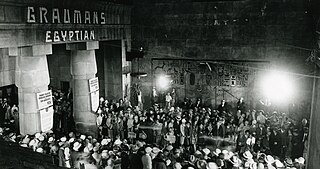
Grauman's Egyptian Theatre, also known as Egyptian Hollywood and the Egyptian, is a historic movie theater located on Hollywood Boulevard in Hollywood, Los Angeles, California. Opened in 1922, it is an early example of a lavish movie palace and is noted as having been the site of the world's first film premiere.
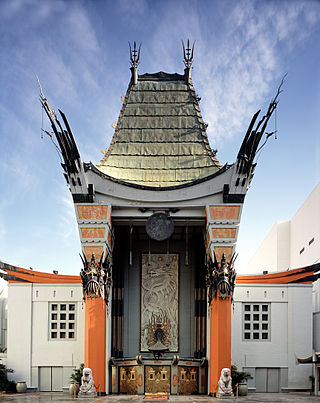
The TCL Chinese Theatre, commonly referred to as Grauman's Chinese Theatre, is a movie palace on the historic Hollywood Walk of Fame in the Hollywood neighborhood of Los Angeles.

Ovation Hollywood is a shopping center and entertainment complex at the intersection of Hollywood Boulevard and Highland Avenue in the Hollywood neighborhood of Los Angeles, California, United States.

El Capitan Theatre is a fully restored movie palace at 6838 Hollywood Boulevard in the Hollywood neighborhood in Los Angeles, California, United States. The theater and adjacent Hollywood Masonic Temple are owned by The Walt Disney Company and serve as the venue for a majority of the Walt Disney Studios' film premieres.

The Pellissier Building and adjoining Wiltern Theatre is a 12-story, 155-foot (47 m) Art Deco landmark at the corner of Wilshire Boulevard and Western Avenue in Los Angeles, California. The entire complex is commonly referred to as the Wiltern Center. Clad in a blue-green glazed architectural terra-cotta tile and situated diagonal to the street corner, the complex is considered one of the finest examples of Art Deco architecture in the United States. The Wiltern building is owned privately, and the Wiltern Theatre is operated by Live Nation's Los Angeles division.

The Alex Theatre is a landmark located at 216 North Brand Boulevard in Glendale, California, United States. It is currently owned by the city of Glendale and operated by SAS. The theater's capacity is 1,400.
The Long Beach Museum of Art is a museum located on Ocean Boulevard in the Bluff Park neighborhood of Long Beach, California, United States.
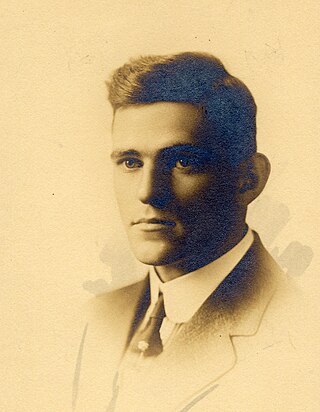
Raymond McCormick Kennedy (1891–1976) was the guiding light and architect of the Grauman's Chinese Theater that opened in May 1927.
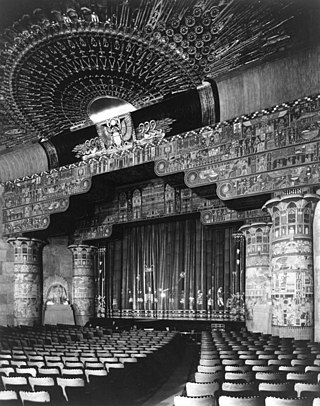
Egyptian-style theatres are based on the traditional and historic design elements of Ancient Egypt.

The Hollywood Pantages Theatre, formerly known as RKO Pantages Theatre and Fox-Pantages Theatre, also known as The Pantages, is a live theater and former movie theater located at 6233 Hollywood Boulevard, near Hollywood and Vine, in the Hollywood neighborhood of Los Angeles, California. Designed by architect B. Marcus Priteca, the theater was the last built by the vaudeville impresario Alexander Pantages and also the last movie palace built in Hollywood.

Harbor Boulevard is a north–south road corridor in the counties of Los Angeles and Orange. One of the busiest routes in Orange County, the thoroughfare passes through some of the most densely populated areas in the region and carries about 8 percent of the county's bus riders. The route provides access for local residents to travel to work and for drivers travelling from Valley Boulevard in the City of Industry via Fullerton Road to Newport Beach.

Golden Gate Theater is a former California Churrigueresque-style movie palace built in 1927 on Whittier Boulevard in East Los Angeles, California. In 1982, it was listed on the National Register of Historic Places. The theater closed in 1986; the retail building built around it was damaged in the 1987 Whittier Narrows earthquake and demolished in 1992. The remaining theater building was left vacant for more than 20 years as preservationists fought with owners and developers over the future of the building. It was finally converted into a CVS Pharmacy and reopened in 2012.

The Broadway Theater District in the Historic Core of Downtown Los Angeles is the first and largest historic theater district listed on the National Register of Historic Places (NRHP). With twelve movie palaces located along a six-block stretch of Broadway, it is the only large concentration of movie palaces left in the United States. The same six-block stretch of Broadway, and an adjacent section of Seventh Street, was also the city's retail hub for the first half of the twentieth century, lined with large and small department stores and specialty stores.
Meyer & Holler was an architecture firm based in Los Angeles, California, noted for its opulent commercial buildings and movie theatres, including Grauman's Chinese and Egyptian theatres, built during the 1920s. Meyer & Holler was also known as The Milwaukee Building Company.
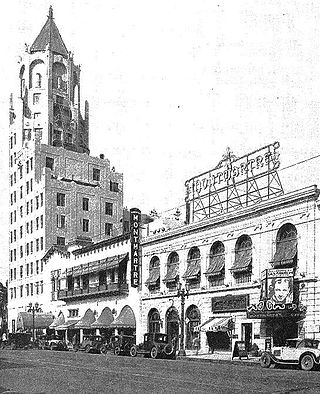
Café Montmartre was a restaurant and nightclub on Hollywood Boulevard at Highland Avenue in Hollywood, Los Angeles, California, US. Opened in 1923, it became a "worldwide center for celebrity and nightlife" during the 1920s and a place where tourists would visit to try to break into Hollywood.
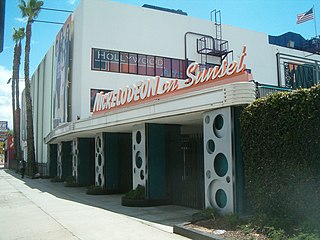
The Earl Carroll Theatre was a historic stage facility located at 6230 Sunset Boulevard in Hollywood, California. It was built by showman Earl Carroll and designed in the Streamline Moderne style by architect Gordon Kaufmann in 1938. The theatre has been known by a number of names since, including Moulin Rouge from 1953 to 1964 and the Aquarius Theater in the 1960s and 1970s. From 1997 to 2017, it was officially known as Nickelodeon on Sunset, housing the West Coast production of live-action original series produced for the Nickelodeon cable channel.

The Visalia Fox Theatre is a landmark movie palace and theater in downtown Visalia, California. Opened in 1930 as a part of the Fox Theatre chain, it was converted to a three screen multiplex in 1976. After a brief closure in the late 1990s, it was restored by a community group and reopened in 1999 as a live performance auditorium with a seating capacity of 1,275.

Petersen Building is a historic two-story building at 7001 W. Hollywood Boulevard in Hollywood, California.






















